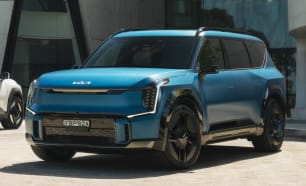It’s large and you have ample space throughout the car. Even third rowers don’t miss out.
It feels quite van-like with the high seat positioning and extending centre console but you get a great view out of the massive windows.
The electrically-adjustable front seats are very comfortable but the mesh ergonomic headrests are a little too comfy!
The boxy steering wheel is nice to use but cut into my vision of the climate control screen from my driving position. I felt like I was looking around it a lot.
Individual storage is fantastic in all three rows. Up front you get a little pocket in the armrest and a huge shelf underneath the centre console.
The glove box is large, but curiously, has a small aperture. There are retractable cupholders in the centre console utility tray and drink bottle holders in each door.
The middle row has two drink bottle holders, four cupholders, two map pockets and a deep but narrow storage cubby at the back of the centre console.
Third rowers are not forgotten, either, with four cupholders and directional air vents to enjoy.
Amenities are great throughout the car and my son loves having the retractable sun-blinds and his own climate control in the middle row. It’s also an easy car to get in and out of, which we both enjoy!
The middle row's 60/40 split is a practical touch and they can be shifted manually or electrically with a one-touch button for access to the third row.
Speaking of which, there is an okay amount of room for my 168cm (5'6") height in the third row (if you push the middle row forward a smidge). And it doesn’t feel claustrophobic thanks to the wide windows.
If you have a pile of kids to shove in this car, you’ll be happy that this row also features two ISOFIX child seat mounts and two top tethers.
I wouldn’t want to be climbing into the third row to buckle in a kid, so reserve these seats for older kids.
The technology looks good but is simple to use which is always a good combination. There are plenty of charging options to choose from with each row getting two USB-C ports, while the front also enjoys a 12-volt socket and a wireless charging pad.
The touchscreen multimedia system is responsive and easy enough to use but the controls on this panel can be difficult to see and use. They’re not always responsive.
I like the satellite navigation and the way the head-up display pulls through the directions. There’s wired Apple CarPlay and Android Auto, too.
The digital instrument cluster is mildly customisable and easy to read. There is a little control panel on the driver’s door which houses the buttons for most of the added seat functions. But it’s hard to read as all the buttons are almost identical.
The boot is a good size when all seats are in use at 333L, which is plenty for my day-to-day errands, but pop the third row down and that jumps up to 828L.
Not as big as you might expect in a car of this size but that’s the compromise of going electric. The batteries have to go somewhere.
You do get a 52L frunk at the front, for cable storage. The loading space is level and you only get a tyre repair kit rather than a physical spare but it’s handy having the powered tailgate.

